エリアンサス遺伝資源データベース

JIRCAS-Erianthus データベースにようこそ
JIRCAS-Erianthusデータベースは、国際農林水産業研究センター(国際農研)のサトウキビプロジェクトにおいて、国際農研とコンケン畑作物研究センター(KKFCRC)が共同で収集した、タイのサトウキビ近縁属遺伝資源エリアンサス(エリアンサスとは、タイのエリアンサス遺伝資源を参照)の形態特性や農業特性の情報を掲載しています。エリアンサスは、サトウキビの育種素材やバイオマス作物として非常に魅力的な特徴を具えていますが、効果的な利用に必要な基礎情報が不足しています。本データベースは、タイに存在するエリアンサス遺伝資源の多様な基礎情報を提供することで、タイはもとより、世界的なエリアンサス利用の促進に貢献することを目的として作成しました。
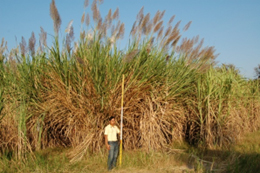
タイのエリアンサス(写真提供:杉本明)
エリアンサスとは
エリアンサス属植物は、C4型光合成を行う熱帯原産のイネ科多年生草本で、サトウキビの近縁遺伝資源です。南アジアから東南アジア、東アジアにかけて分布するOld world speciesとアメリカ大陸に分布するNew world species に分類されています。Old world speciesは、サトウキビの成立に関わったSaccharum complexの一つとされており、E. arundinaceus (Retz) Jeswiet.、E. procerus (Roxb.), E. kanashiroi (Ohwi), E. bengalense (Retz), E. ravennae (L.) P Beauv., E. hostii Griseb., E. elephantinus (Hook.f.) 等が知られています [1,2]。
エリアンサスは、株の再生力が優れ、バイオマス生産性が高いことが大きな特徴です。また、干ばつや湛水、低肥沃度土壌等の不良な環境への適応性が高く、耐病性や耐虫性などの特性も具えています。そのため、サトウキビ育種の重要な育種素材として注目されています[1]。また、エリアンサスの高いバイオマス生産性に注目し、エリアンサス自体をバイオマス作物として燃料や電力生産、バイオエタノール生産、パルプ生産などに利用する取り組みも進められています[3]。
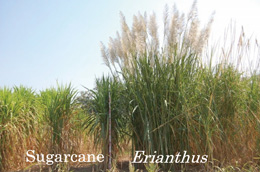
エリアンサスとサトウキビ(撮影地:タイ国コンケン、提供:佐藤光徳)
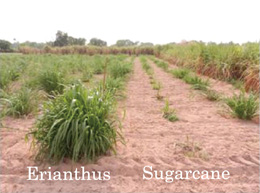
エリアンサスとサトウキビの萌芽(撮影地:タイ国コンケン、提供:寺島義文)
国際農研のサトウキビプロジェクト
サトウキビの生産性や不良環境適応性等の更なる改良に向けて、育種素材の遺伝的多様性の低さが課題となっています。この問題を解決するためには、生産性や不良環境適応性に優れる近縁遺伝資源の利用が重要になります。
国際農研とタイ国のコンケン畑作物研究センターは、タイに豊富に自生するエリアンサス遺伝資源の収集を行うとともに、タイのサトウキビ育種事業の中で、それら遺伝資源の利用を促進するための基礎育種技術や基礎情報の整備を行ってきました[4, 5, 6]。
エリアンサス遺伝資源を効果的に利用するためには、多様な遺伝資源から目的とする材料を選び、育種などに利用していくことが必要です。エリアンサス遺伝資源はインドやインドネシア、中国などで収集されていますが、その特性に関する公開情報は世界的にも少なく、利用されている遺伝資源も極わずかでした。
そこで私たちは、タイのエリアンサス遺伝資源の特性情報を他の育種家や研究者と共有することを目的に、収集した形態特性や農業特性のデータを利用してこのデータベースを作成しました。
本データベースを公開することで、タイやその他の国々におけるサトウキビ育種や研究、バイオマス利活用におけるエリアンサスの利用が促進され、世界の食料やエネルギーの増産に貢献することを期待しています。
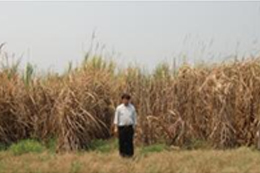
乾期に枯れ上がるサトウキビ(撮影地:タイ国コンケン、提供:寺島義文)
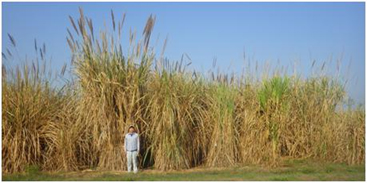
エリアンサス伝資源評価圃場(撮影地:タイ国コンケン、提供:寺島義文)
タイのエリアンサス遺伝資源
国際農研とコンケン畑作物研究センターは、1997年から2010年まで、タイ全土からエリアンサス遺伝資源の収集を行ってきました。タイで収集した遺伝資源には、E. procerus および E. arundinaceus の2種のエリアンサスが含まれています。特に、E. arundinaceus は多様性が大きく、特性の異なる3タイプに分類できます[4, 5]。タイには、異なる倍数体、様々な形態学的および農業的特徴を示す多様な E. arundinaceus と E. procerus の遺伝資源が存在しています。これら遺伝資源は、タイだけでなく世界的にも貴重な遺伝資源になると考えられます。
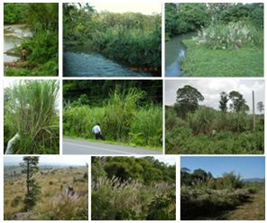
エリアンサス伝資源の収集(撮影地:タイ国、提供:田金秀一郎、寺島義文)
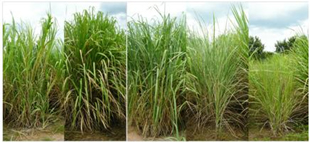
多様なエリアンサス遺伝資源の草姿(撮影地:タイ国コンケン、提供:寺島義文)
Erianthus procerus
- 染色体数:2n = 40
- 出 穂 期:12月~2月
- 特 性:茎は細茎で直立し、茎数は多い。葉鞘は無毛で、ロウ質物が多い。各節にある芽と根基の発達は乏しく、茎からの栄養繁殖が難しい。出穂は遅い。
- 生育環境:山地林縁、丘陵草地、路傍など。
- 収集地域:北部~東北部
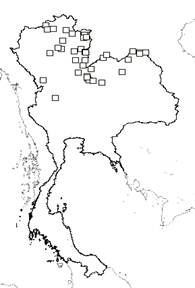
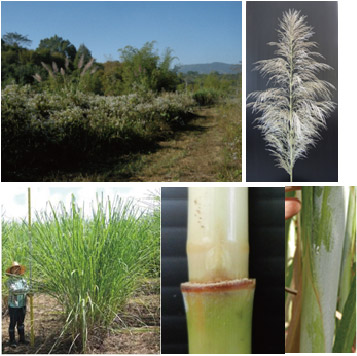
Erianthus arundinaceus (Type I)
- 染色体数:2n = 60
- 出 穂 期:11月~1月
- 特 性:細茎で茎数が多い。葉鞘に毛が密生するのが特徴。様々な環境に適応し、多様な変異がみられる。
- 生育環境:山地林縁、丘陵草地、路傍など
- 収集地域:マレー半島以外のタイ全土
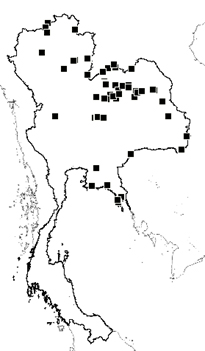
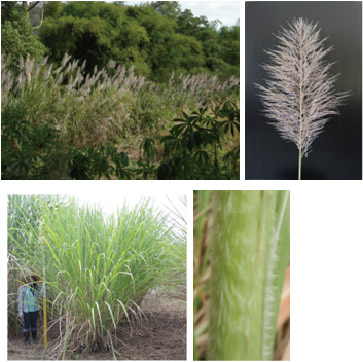
Erianthus arundinaceus (Type II)
- 染色体数:2n = 60
- 出 穂 期:12月~2月
- 特 性:茎径が大きい、葉鞘の毛は無毛か極少なく、ワックスが多い。茎部が発達し芽子は大きく、根基も多いため、栄養繁殖が容易
- 生育環境:河川沿い、湿地
- 収集地域:タイ南部およびマレー半島
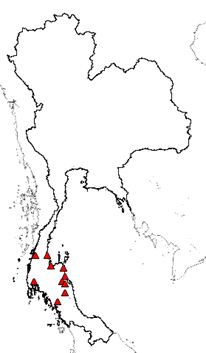
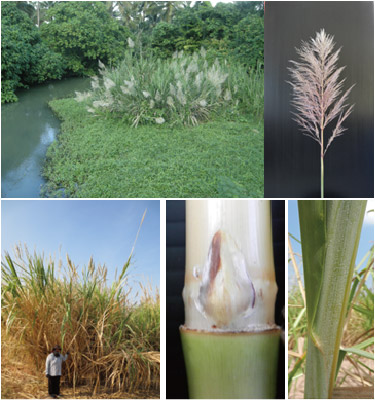
Erianthus arundinaceus (Type III)
- 染色体数:2n = 40
- 出 穂 期:10月~11月
- 特 性:葉鞘には毛、ワックスは無く、アントシアニンの蓄積が見られる。Type IIと同様に、茎部が発達し、芽子は大きく、根基も多いため、栄養繁殖が容易。出穂が早い。
- 生育環境:河川沿い、湿地
- 収集地域:タイ南部、東部、東北部、北部
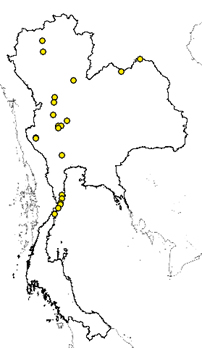
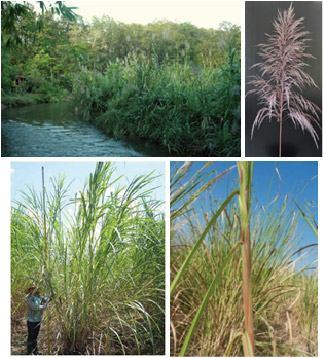
謝辞
本データベースの作成にあたり、多くの方のご協力を頂きました
協力頂いたすべての方々に、感謝の意を表します
(敬称略)
タイ農業局コンケン畑作物研究センター (KKFCRC)
Werapon Ponragdee, Amarawan Tippayawat, Sangdaun Chanachai, Taksina Sansayawichai, Rianthong Pansaita, Peaingpen Sarawat, Somsit Juntarak, Jiraluck Phoomthaisong
国立研究開発法人 国際農林水産業研究センター(JIRCAS)
(https://www.jircas.go.jp/ja)
杉本明、田金秀一郎(現九州大学)、霍田真一、平田正和、識名安輝、大和浩二、波照閒雄人、喜屋武みつる、真喜屋なおみ、星麻紀、村中聡、林賢紀、加納健、中島一雄、飯山みゆき
筑波大学
(http://www.tsukuba.ac.jp/en/)
林 久喜
D-blauer-strom
蓮沼ユウキ
国際農林水産業研究センターサトウキビプロジェクト
寺島義文、高木洋子、安藤象太郎、山中愼介
参考文献
1. Jackson, P., and Henry R. J. (2011). Erianthus. In C. Kole eds., Wild Crop Relatives: Genomic and Breeding Resources, Industrial Crops. Springer-Verlag. Berlin. 97-107.
2. Mukherjee, S. K. (1957). Origin and distribution of Saccharum. Bot. Gaz. 119: 55-61.
3. Terajima, Y., Gau, M., Uwatoko, N., Sugimoto, A. (2015). JEC1, a new variety of Erianthus with higher mechanical harvesting efficiency. Japan International Research Center for Agirucultural Sciences, Research Highlights. B-07. (https://www.jircas.go.jp/ja/publication/research_highlights)
4. Tagane, S., Ponragdee, W., Sansayawichai, T, Sugimoto, A., Terajima, Y. (2012). Characterization and taxonomical note about Thai Erianthus germplasm collection: the morphology, flowering phenology and biogeography among E. procerus and three types of E. arundinaceus. Genet Resour Crop Evol. 59:769-781.
5. Tsuruta, S., Srithawong, S., Sakuanrungsirikul, S., Ebina, M., Kobayashi, M., Terajima, Y., Tippayawat, A., Ponragdee, W. (2022). Erianthus germplasm collection in Thailand: genetic structure and phylogenetic aspects of tetraploid and hexaploid accessions. BMC Plant Biol 22, 45. https://doi.org/10.1186/s12870-021-03418-3
6. Terajima, Y., Ponragdee,W., Sansayawichai, T., Tippayawat, A., Chanachai, S.,Ebina, M., Sugimoto, A., Takagi, H., & Hayashi, H.(2022). Genetic variation in agronomic traits of Erianthus germplasm under multiple-ratoon crops in Thailand. Crop Science, 62,1531-1549. https://doi.org/10.1002/csc2.20697
7. UPOV. (2005). Sugarcane (Saccharum L.). International union for the protection of new varieties of plants (UPOV). Geneva. Switzerland. P3-29.
